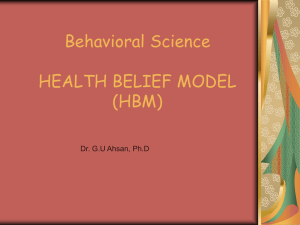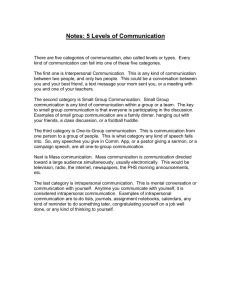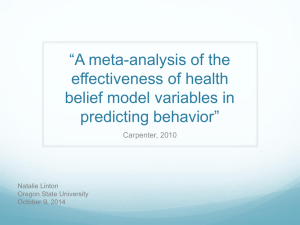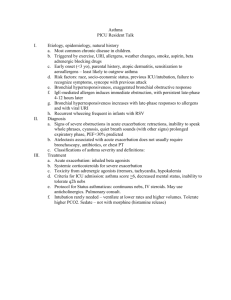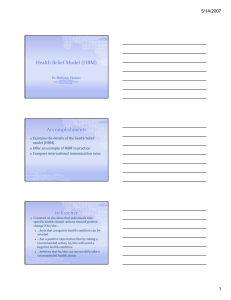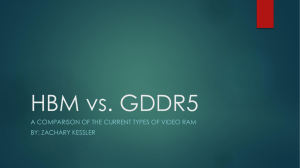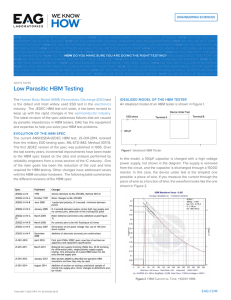H571 Week 8 - Parker 1
advertisement
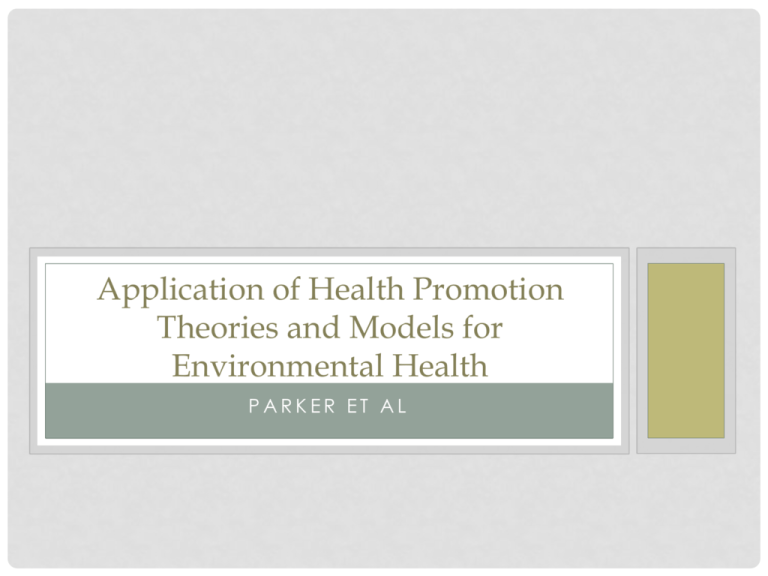
Application of Health Promotion Theories and Models for Environmental Health PARKER ET AL PARKER PAPER • Main goal: • How can Health Promotion Theories be applied to reduce exposure to environmental hazards? • Why is this paper unique? • HP Theories are rarely applied to environmental health issues • Where: Detroit • What: Community Action Against Asthma (CAAA) STUDY DESIGN • 1) Exposure Assessment • 2) Intervention • Household level • Neighborhood/policy level • Participants • 331 households of English/Spanish speaking children, 6-11 yrs • Detroit public schools (SW/E Districts) • Screening • Questionnaire to find those households with children with persistent asthma INTERVENTION DESIGN 12 Visits by Community Environmental Specialists (CES) 2 years Intensive Year 1 Min 9 visits Less Intensive Year 2 Min 3 visits ECOLOGICAL MODEL: A THEORY OF ACTION • Introduced in Week 1 • Health, behavior, & their determinants are interrelated • Response to: environmental barriers can make other HP programs fail to have long-term behavior change • Target multiple levels (as resources allow) & make changes to the physical, legal, economic, social environment => • Strong! Long-lasting! Individual & Environmental Factors Behavior Health ECOLOGICAL MODEL: A THEORY OF ACTION HOW THE ECOLOGICAL MODEL FRAMEWORK WAS USED 1. Assess Physical & Social Environment 1. Decide targets of change at each level 1. Develop intervention strategies for as many targets as possible Individual & Environmental Factors INTRAPERSONAL LEVEL: HBM • HEALTH BELIEF MODEL (refresher) Individual & Environmental Factors INTRAPERSONAL LEVEL: HBM PERCEIVED THREAT & BENEFITS • Perceived Threat: • Stress perceived susceptibility to asthma exacerbation • Allergen type & child-specific allergen info • Reinforce asthma exacerbation if child exposed • Stress perceived susceptibility to increased morbidity & mortality potential • Perceived Benefits • “Explained link between exposure to indoor allergens and irritants and asthma exacerbation” • “Explained how allergens and irritants could be reduced through cleaning behaviors and by preventing the child from being exposed to tobacco smoke.” • Do you think that these are interventions that effectively target the perceived benefits construct? (I’m not sure they do…) Individual & Environmental Factors INTRAPERSONAL LEVEL: HBM BARRIERS AND CUES TO ACTION • Perceived Barriers • Identify & strategize • Competing life demands => agencies that could help • Equip with resources • Cleaning supplies, mattress covers, vacuums • Cues to Action • Shared data from initial data collection • Walkthrough results- visible cockroaches? Visible mold? Dust sample findings • Recommendations from physician about which triggers to focus on • Discussion Question: • Book says “events, symptoms, reminders” Individual & Environmental Factors INTRAPERSONAL LEVEL: HBM SELF-EFFICACY • Caregiver confidence of success (in very specific behavior? Not really specified) • How was it addressed? • Remember, caregiver decidedwhich triggers to target from discussing with CES • Set small action goals caregivers could meet between visits (6-8 weeks) • Verbal encouragement and support from CES to reinforce Individual & Environmental Factors SOCIAL COGNITIVE THEORY: REFRESHER Behavior Major determinants: • Environment Environment Personal factors • • • • Outcome expectations Self-efficacy Behavioral capability Methods for behavioral change • (…where is goal formation?) Individual & Environmental Factors INTRAPERSONAL LEVEL: SCT • Knowledge and Skills • Share knowledge and skills needed to perform behavior like cleaning • Self-efficacy • intervention same as described for HBM previously • Set small goals & reinforce behavioral change with verbal encouragement & support • Methods of Learning (specifically observational) • Model all desired actions (vacuuming, dusting, etc) + reinforcements • Environment • “Project planners took into consideration the SCT’s definition of environment” • Understand that caregivers might not be able to alter their environment if they rent their homes => add in tenant-advocate organization • Where are outcome expectations and expectancies? Individual & Environmental Factors SOCIAL SUPPORT • Social Support • • • • Emotional Instrumental: tangible aid/services Informational: advice, suggestions, info Appraisal: feedback • How did they address it? CES (Community environmental specialist) Informational Give info Emotional Care, empathy Instrumental Cleaning supplies, bed covers Appraisal Constructive feedback Individual & Environmental Factors SOCIAL NETWORKS • Increase caregiver’s coping resources • Matched to community resources • Ex: Persons with mental health needs to mental health services • Resources in the community • Increase neighborhood and community support for families with children with asthma • Reduce environmental triggers on community level

